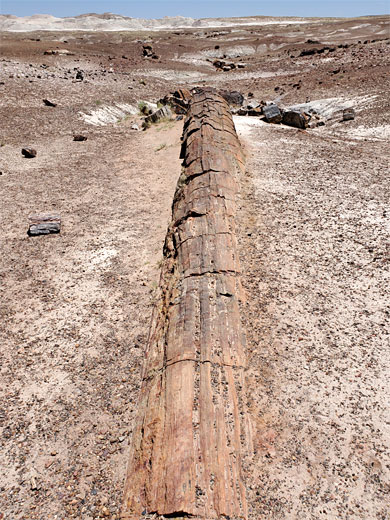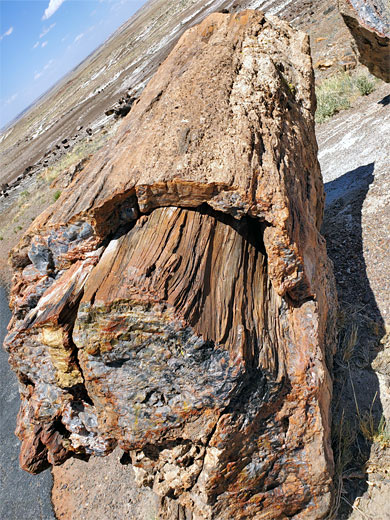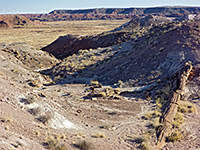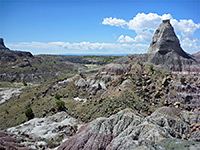Crystal Forest Trail, Petrified Forest National Park
Arizona > Petrified Forest National Park > Hiking > Crystal Forest Trail
Crystal Forest Trail
Paved loop through an area once strewn with especially beautiful logs, which had crevices containing clear quartz and purple amethyst crystals. The best specimens were removed by souvenir hunters long ago but some smaller crystalline specimens can still be seen, amongst other many more typical logs, large and colorful
Length: 0.75 mile (loop)
Elevation change: 30 feet
Difficulty: Easy
Type: Loop
Usage: High
Season: All year
Trailhead: Parking lot along the park drive
Rating (1-5): ★★★★★
Elevation change: 30 feet
Difficulty: Easy
Type: Loop
Usage: High
Season: All year
Trailhead: Parking lot along the park drive
Rating (1-5): ★★★★★
The Triassic-era conifers that comprise most of the fossilized logs in Petrified Forest National Park were buried by stream-deposited sediment, including volcanic ash, then gradually turned to stone by the slow replacement of organic matter by silica, to form quartz. For most of the logs in the park, the mineral is massive, lacking obvious crystalline faces, but in one section the fossils contain cavities in which actual crystals were found, a mix of clear quartz and purple amethyst - a region that became known as the Crystal Forest.
Although all the best specimens were removed long ago by souvenir hunters, some of whom even blew up large logs using dynamite to extract the crystalline inclusions, a few small examples remain, while the area also has many more conventional logs, typically large, varied in form, and beautifully coloured.
The Crystal Forest may be viewed along an easy, paved, three quarters of a mile loop trail, one of the most popular paths in the park, across flat terrain of small mounds and little gullies, with the fossils strewn all around. All the bedrock hereabouts is from the Blue Mesa Member of the Chinle Formation, a mix of sandstone and mudstone.
The Crystal Forest Trail starts at a parking area on the east side of the scenic drive, with space for around 30 vehicles - 8 miles north of the southern entrance station along US 180, and 20 miles from the northern entrance. The trail heads east a short distance to a junction, at the start of the loop. The right branch crosses a little wash and winds through the undulating badlands, in which in some parts are quite barren and others strewn with the petrified logs. The path curves left and right in order to stay fairly level, then after while it moves round to the north and then back east; along this section are some especially long logs, up to 50 feet. The last section heads southwest, ending with a short climb to the top of a mound, site of a shaded viewing platform, this almost back at the parking place.
Although all the best specimens were removed long ago by souvenir hunters, some of whom even blew up large logs using dynamite to extract the crystalline inclusions, a few small examples remain, while the area also has many more conventional logs, typically large, varied in form, and beautifully coloured.
The Crystal Forest may be viewed along an easy, paved, three quarters of a mile loop trail, one of the most popular paths in the park, across flat terrain of small mounds and little gullies, with the fossils strewn all around. All the bedrock hereabouts is from the Blue Mesa Member of the Chinle Formation, a mix of sandstone and mudstone.
The Trail
The Crystal Forest Trail starts at a parking area on the east side of the scenic drive, with space for around 30 vehicles - 8 miles north of the southern entrance station along US 180, and 20 miles from the northern entrance. The trail heads east a short distance to a junction, at the start of the loop. The right branch crosses a little wash and winds through the undulating badlands, in which in some parts are quite barren and others strewn with the petrified logs. The path curves left and right in order to stay fairly level, then after while it moves round to the north and then back east; along this section are some especially long logs, up to 50 feet. The last section heads southwest, ending with a short climb to the top of a mound, site of a shaded viewing platform, this almost back at the parking place.
Crystal Forest Wildflower
 Fendler's hedgehog |
Crystal Forest Trail - Similar Hikes
All Contents © Copyright The American Southwest | Comments and Questions | Contribute | Affiliate Marketing Disclosure | Site Map














